steering FORD F-59 2021 Owner's Guide
[x] Cancel search | Manufacturer: FORD, Model Year: 2021, Model line: F-59, Model: FORD F-59 2021Pages: 191, PDF Size: 2.84 MB
Page 129 of 191
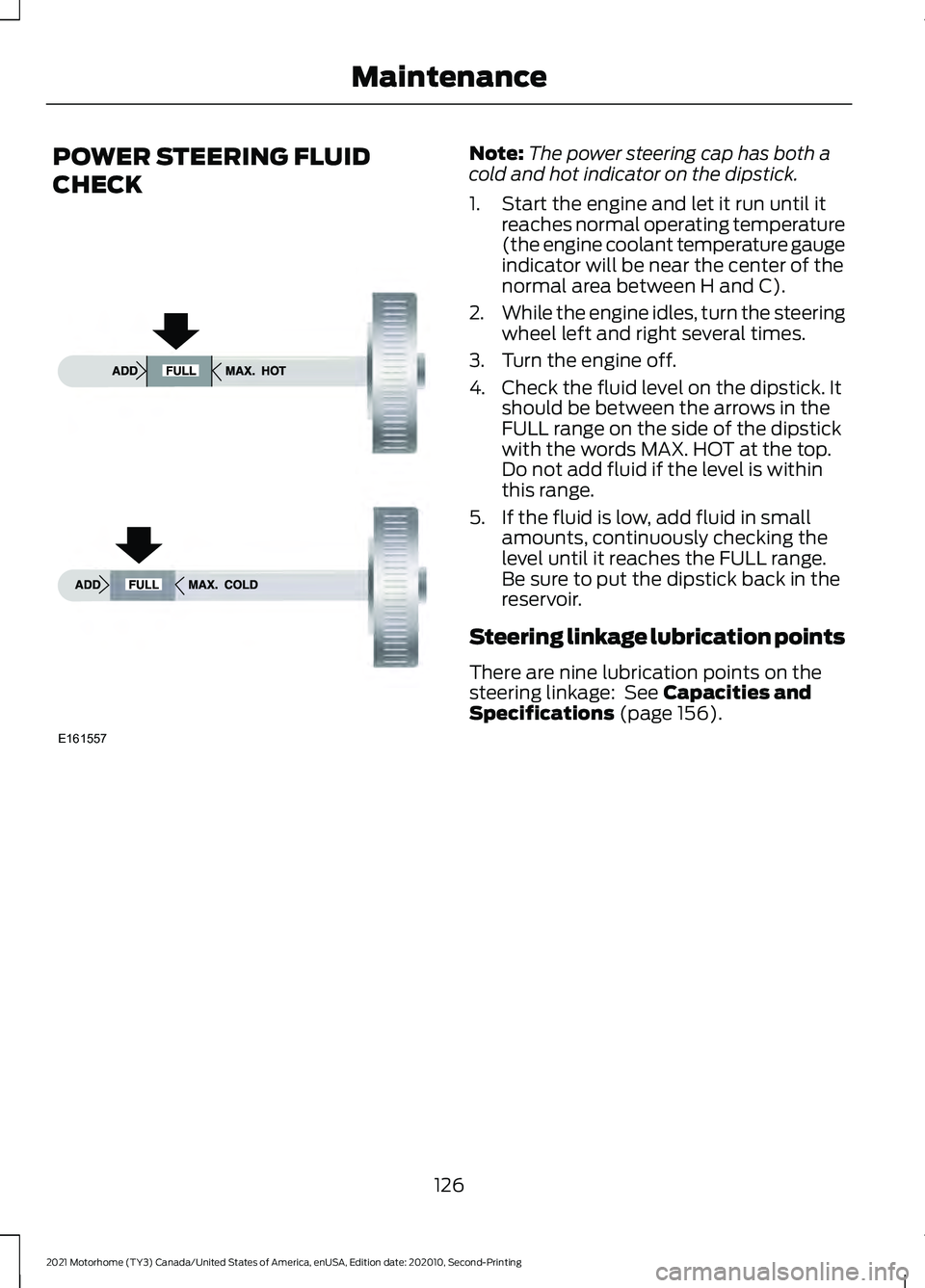
POWER STEERING FLUID
CHECK Note:
The power steering cap has both a
cold and hot indicator on the dipstick.
1. Start the engine and let it run until it reaches normal operating temperature
(the engine coolant temperature gauge
indicator will be near the center of the
normal area between H and C).
2. While the engine idles, turn the steering
wheel left and right several times.
3. Turn the engine off.
4. Check the fluid level on the dipstick. It should be between the arrows in the
FULL range on the side of the dipstick
with the words MAX. HOT at the top.
Do not add fluid if the level is within
this range.
5. If the fluid is low, add fluid in small amounts, continuously checking the
level until it reaches the FULL range.
Be sure to put the dipstick back in the
reservoir.
Steering linkage lubrication points
There are nine lubrication points on the
steering linkage: See Capacities and
Specifications (page 156).
126
2021 Motorhome (TY3) Canada/United States of America, enUSA, Edition date: 202010, Second-Printing MaintenanceE161557
Page 130 of 191
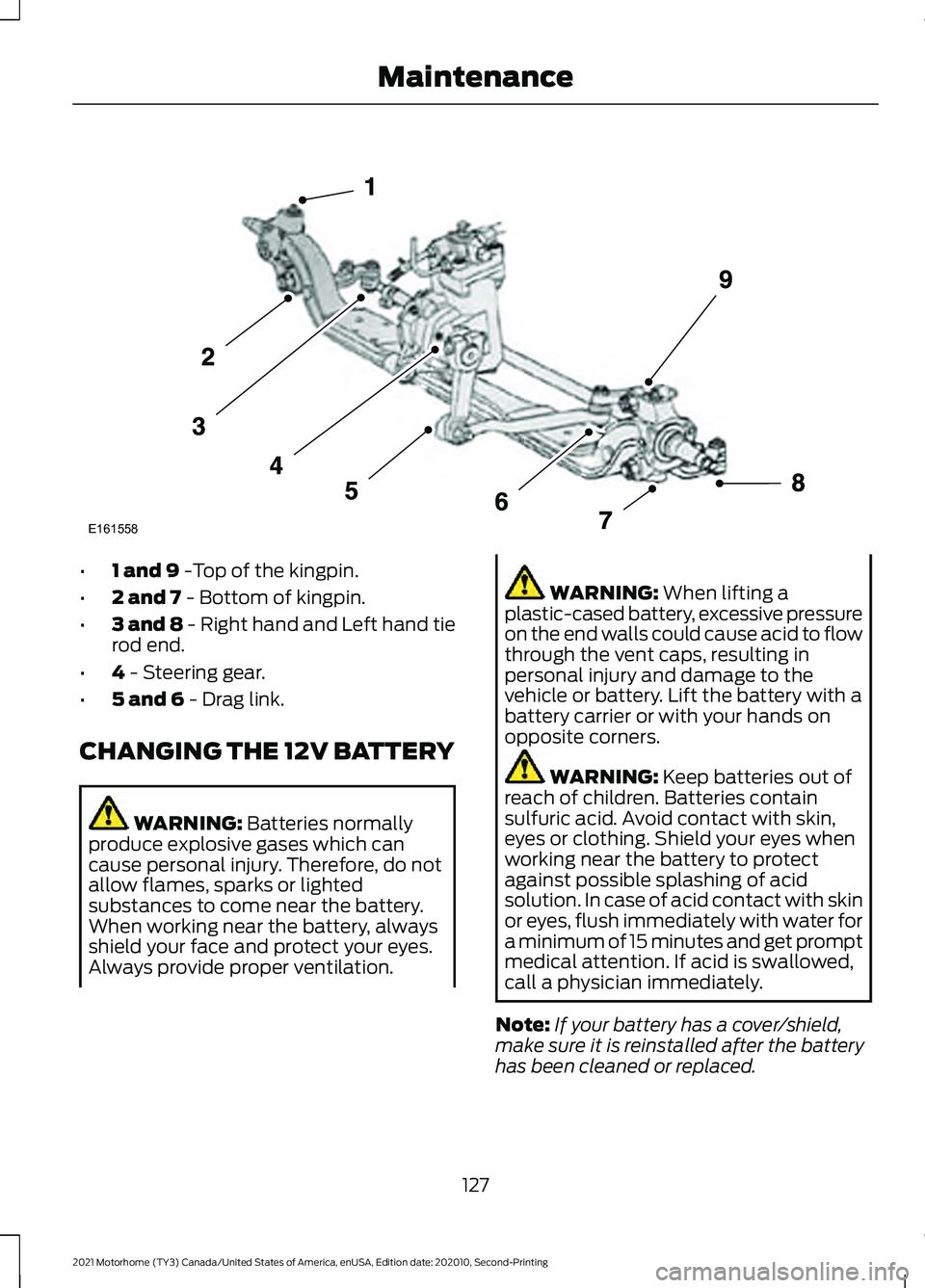
•
1 and 9 -Top of the kingpin.
• 2 and 7
- Bottom of kingpin.
• 3 and 8 - Right hand and Left hand tie
rod end.
• 4
- Steering gear.
• 5 and 6
- Drag link.
CHANGING THE 12V BATTERY WARNING:
Batteries normally
produce explosive gases which can
cause personal injury. Therefore, do not
allow flames, sparks or lighted
substances to come near the battery.
When working near the battery, always
shield your face and protect your eyes.
Always provide proper ventilation. WARNING:
When lifting a
plastic-cased battery, excessive pressure
on the end walls could cause acid to flow
through the vent caps, resulting in
personal injury and damage to the
vehicle or battery. Lift the battery with a
battery carrier or with your hands on
opposite corners. WARNING:
Keep batteries out of
reach of children. Batteries contain
sulfuric acid. Avoid contact with skin,
eyes or clothing. Shield your eyes when
working near the battery to protect
against possible splashing of acid
solution. In case of acid contact with skin
or eyes, flush immediately with water for
a minimum of 15 minutes and get prompt
medical attention. If acid is swallowed,
call a physician immediately.
Note: If your battery has a cover/shield,
make sure it is reinstalled after the battery
has been cleaned or replaced.
127
2021 Motorhome (TY3) Canada/United States of America, enUSA, Edition date: 202010, Second-Printing MaintenanceE161558
Page 153 of 191

USING SNOW CHAINS
WARNING: Wheels and tires must
be the same size, load index and speed
rating as those originally fitted on the
vehicle. Use of any other tire or wheel
can affect the safety and performance
of your vehicle. Additionally, the use of
non-recommended tires and wheels can
cause steering, suspension, axle, transfer
case or power transfer unit failure.
Follow the recommended tire inflation
pressures found on the Safety
Compliance Certification label, or the
Tire Label on the B-Pillar or the edge of
the driver door. Failure to follow this
instruction could result in loss of vehicle
control, vehicle rollover, or personal injury
or death.
The tires on your vehicle have all-weather
treads to provide traction in rain and snow.
However, in some climates, you may need
to use snow tires and cables. If you need
to use cables, it is recommended that steel
wheels (of the same size and
specifications) be used, as cables may chip
aluminum wheels. Note:
The suspension insulation and
bumpers help prevent vehicle damage. Do
not remove these components from your
vehicle when using snow tires and chains.
Follow these guidelines when using snow
tires and chains:
• If possible, avoid fully loading your
vehicle.
• Install chains securely, verifying that
the chains do not touch any wiring,
brake lines or fuel lines.
• Drive cautiously. If you hear the chains
rub or bang against your vehicle, stop
and retighten the chains. If this does
not work, remove the chains to prevent
damage to your vehicle.
• Remove the tire chains when they are
no longer needed. Do not use tire
chains on dry roads.
Please contact your coach builder for
approved snow chain types/sizes and
other recommendations for snow chain
use.
150
2021 Motorhome (TY3) Canada/United States of America, enUSA, Edition date: 202010, Second-Printing Wheels and Tires
Page 157 of 191
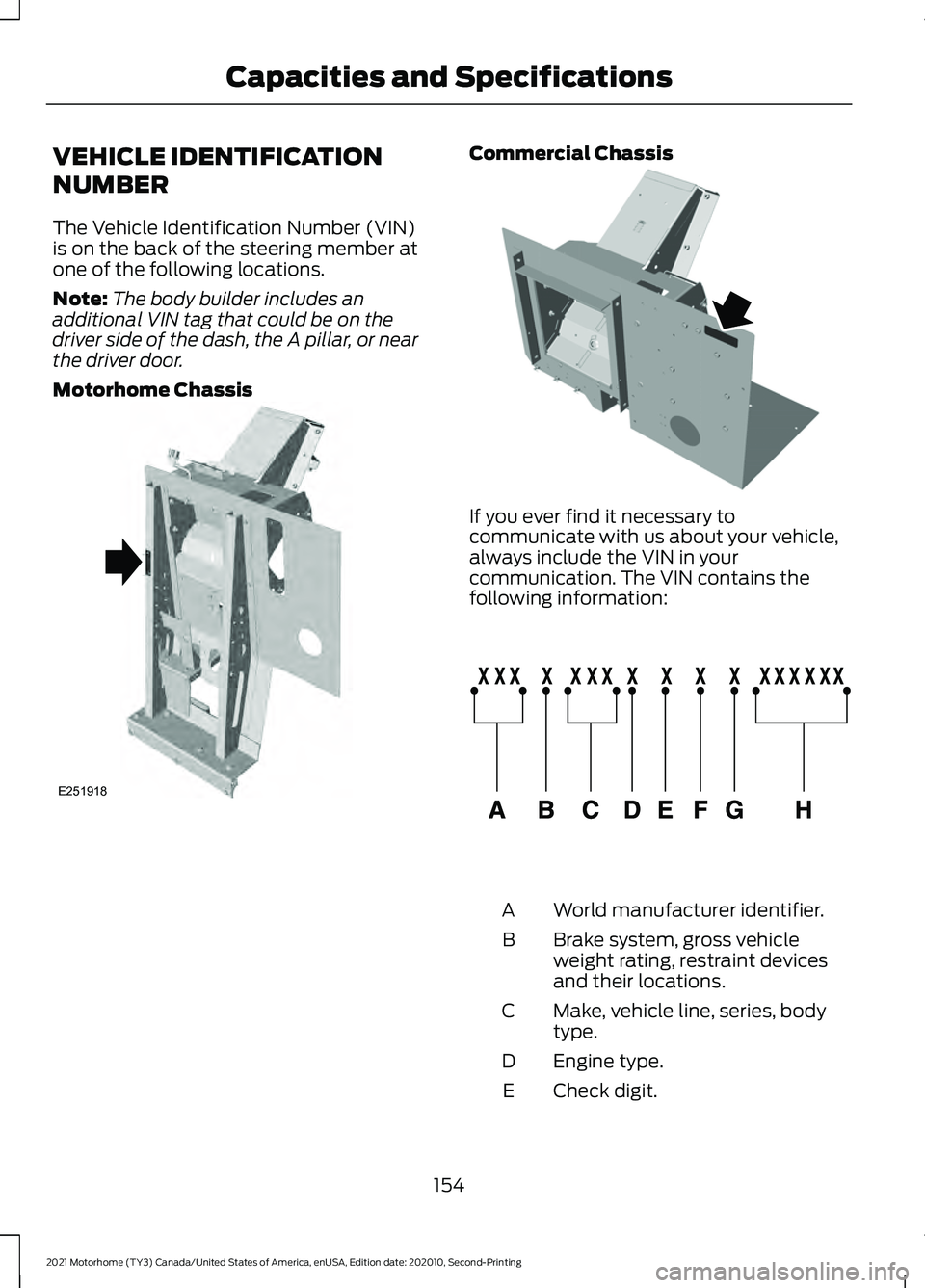
VEHICLE IDENTIFICATION
NUMBER
The Vehicle Identification Number (VIN)
is on the back of the steering member at
one of the following locations.
Note:
The body builder includes an
additional VIN tag that could be on the
driver side of the dash, the A pillar, or near
the driver door.
Motorhome Chassis Commercial Chassis
If you ever find it necessary to
communicate with us about your vehicle,
always include the VIN in your
communication. The VIN contains the
following information:
World manufacturer identifier.
A
Brake system, gross vehicle
weight rating, restraint devices
and their locations.
B
Make, vehicle line, series, body
type.
C
Engine type.
D
Check digit.
E
154
2021 Motorhome (TY3) Canada/United States of America, enUSA, Edition date: 202010, Second-Printing Capacities and SpecificationsE251918 E310570 E142477
Page 164 of 191

Hydroboost Brake System
Capacities
Quantity
Variant
Fill as required.
All.
Materials Specification
Name
WSS-M6C65-A3
Motorcraft® DOT 5.1 Motor Vehicle Brake Fluid(U.S.)
Motorcraft® DOT 5.1 Motor Vehicle Brake Fluid /
Liquide de frein automobile DOT 5.1 Motor-
craft®(Canada)
PM-21(U.S. & Canada)
Note: Motorcraft® DOT 5.1 Motor Vehicle
Brake Fluid is for vehicles with Hydroboost
brake booster systems. We recommend
using DOT 5.1 Motor Vehicle Brake Fluid or
equivalent meeting WSS-M6C65-A3. This
includes chassis with gross vehicle weight
ratings of 16,000 lb (7,257 kg), 18,000 lb
(8,165 kg), and 19,500 lb (8,845 kg). Note:
Use of any fluid other than the
recommended fluid could cause reduced
brake performance and not meet our
performance standards. Keep brake fluid
clean and dry. Contamination with dirt,
water, petroleum products or other
materials could result in brake system
damage and possible failure.
Power Steering System
Materials Specification
Name
WSS-M2C938-AMERCON® LV,
Motorcraft® MERCON® LV Automatic Transmission
Fluid(U.S.)
Motorcraft® MERCON® LV Automatic Transmission
Fluid / Huile pour boîte automatique MERCON® LV
Motorcraft®(Canada)
XT-10-QLVC(U.S.)
CXT-10-LV6(Canada)
161
2021 Motorhome (TY3) Canada/United States of America, enUSA, Edition date: 202010, Second-Printing Capacities and Specifications
Page 173 of 191
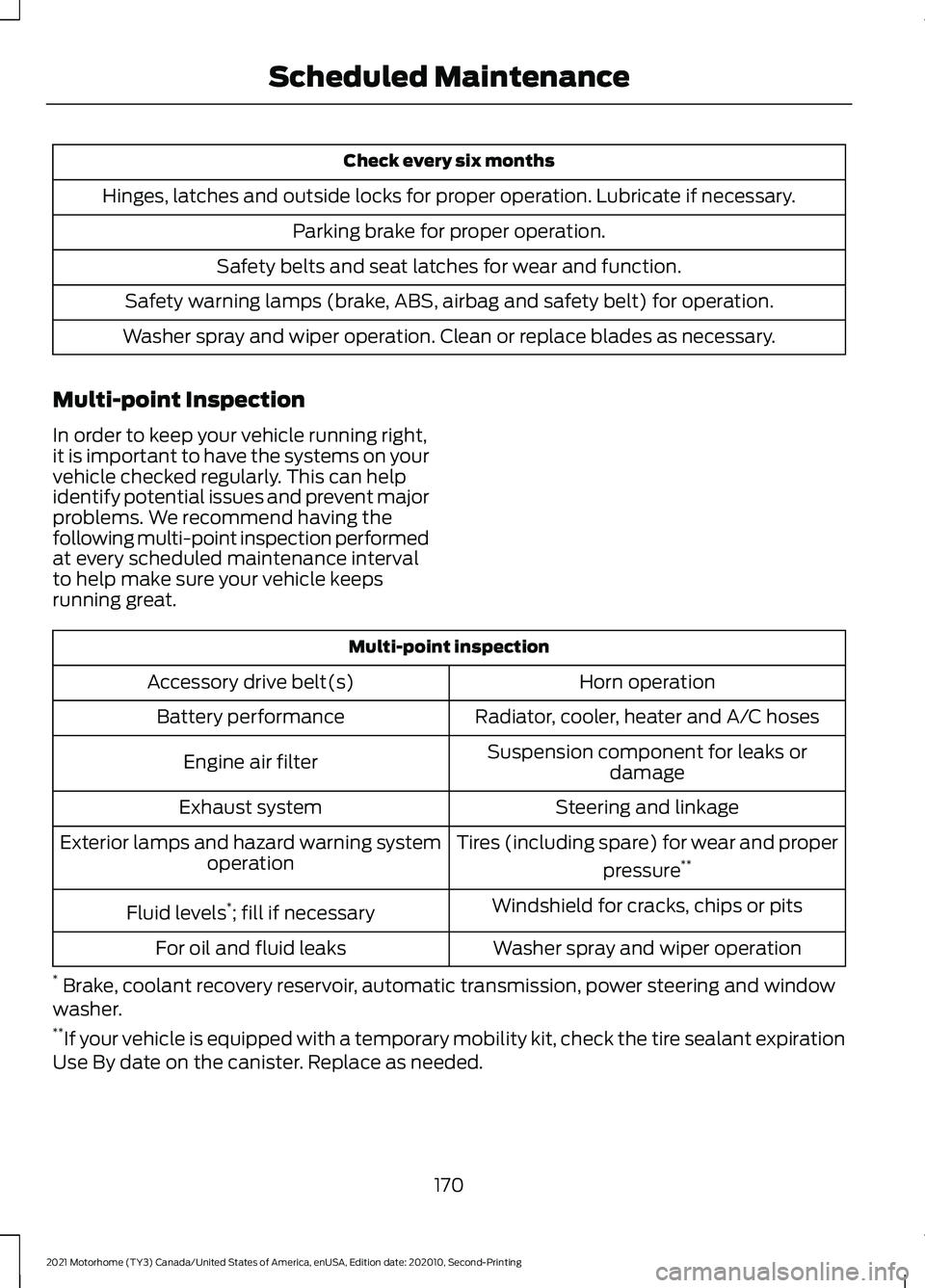
Check every six months
Hinges, latches and outside locks for proper operation. Lubricate if necessary. Parking brake for proper operation.
Safety belts and seat latches for wear and function.
Safety warning lamps (brake, ABS, airbag and safety belt) for operation.
Washer spray and wiper operation. Clean or replace blades as necessary.
Multi-point Inspection
In order to keep your vehicle running right,
it is important to have the systems on your
vehicle checked regularly. This can help
identify potential issues and prevent major
problems. We recommend having the
following multi-point inspection performed
at every scheduled maintenance interval
to help make sure your vehicle keeps
running great. Multi-point inspection
Horn operation
Accessory drive belt(s)
Radiator, cooler, heater and A/C hoses
Battery performance
Suspension component for leaks ordamage
Engine air filter
Steering and linkage
Exhaust system
Tires (including spare) for wear and properpressure**
Exterior lamps and hazard warning system
operation
Windshield for cracks, chips or pits
Fluid levels *
; fill if necessary
Washer spray and wiper operation
For oil and fluid leaks
* Brake, coolant recovery reservoir, automatic transmission, power steering and window
washer.
** If your vehicle is equipped with a temporary mobility kit, check the tire sealant expiration
Use By date on the canister. Replace as needed.
170
2021 Motorhome (TY3) Canada/United States of America, enUSA, Edition date: 202010, Second-Printing Scheduled Maintenance
Page 174 of 191
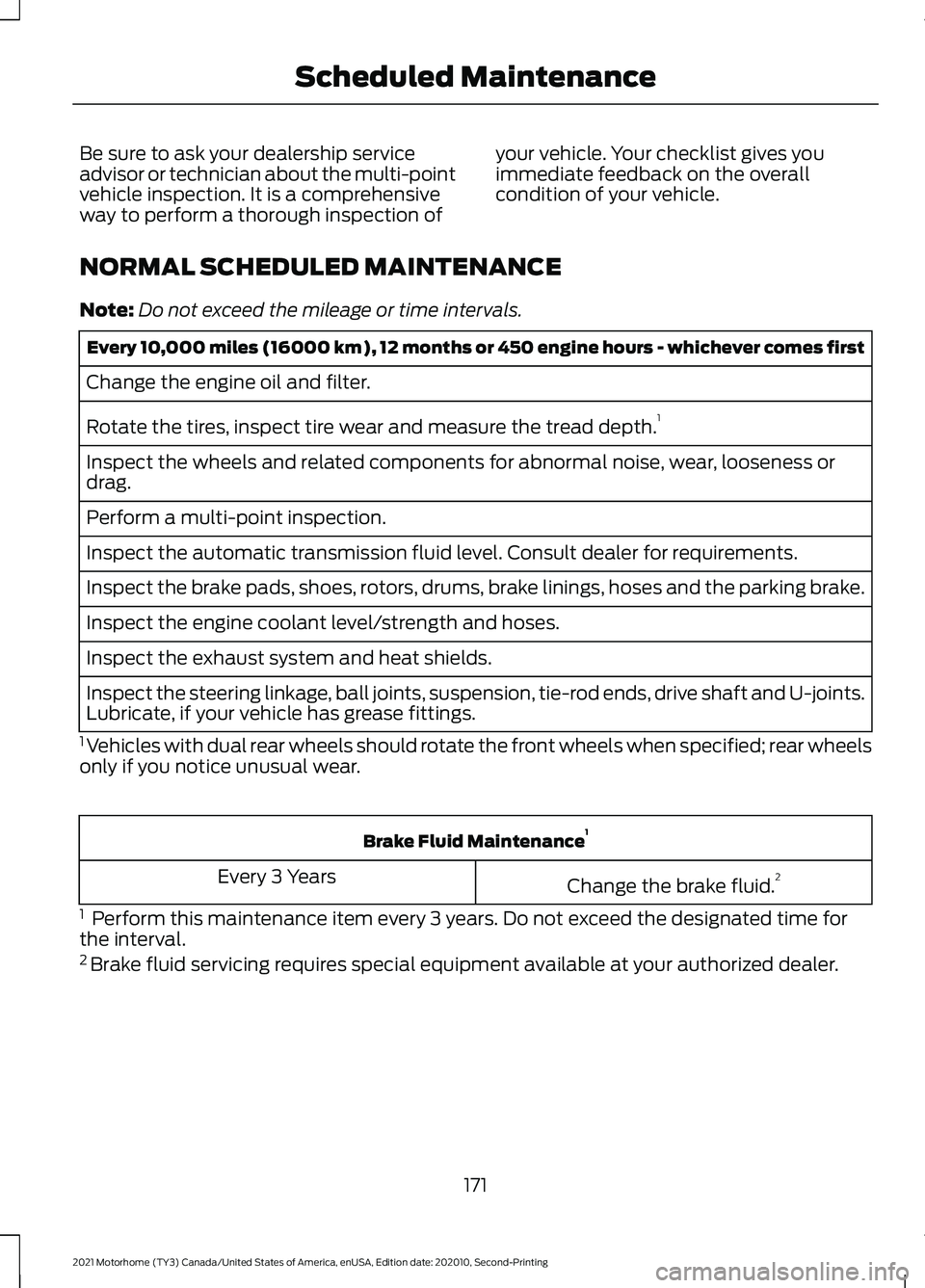
Be sure to ask your dealership service
advisor or technician about the multi-point
vehicle inspection. It is a comprehensive
way to perform a thorough inspection of
your vehicle. Your checklist gives you
immediate feedback on the overall
condition of your vehicle.
NORMAL SCHEDULED MAINTENANCE
Note: Do not exceed the mileage or time intervals. Every 10,000 miles (16000 km), 12 months or 450 engine hours - whichever comes first
Change the engine oil and filter.
Rotate the tires, inspect tire wear and measure the tread depth. 1
Inspect the wheels and related components for abnormal noise, wear, looseness or
drag.
Perform a multi-point inspection.
Inspect the automatic transmission fluid level. Consult dealer for requirements.
Inspect the brake pads, shoes, rotors, drums, brake linings, hoses and the parking brake.
Inspect the engine coolant level/strength and hoses.
Inspect the exhaust system and heat shields.
Inspect the steering linkage, ball joints, suspension, tie-rod ends, drive shaft and U-joints.
Lubricate, if your vehicle has grease fittings.
1 Vehicles with dual rear wheels should rotate the front wheels when specified; rear wheels
only if you notice unusual wear. Brake Fluid Maintenance
1
Change the brake fluid. 2
Every 3 Years
1 Perform this maintenance item every 3 years. Do not exceed the designated time for
the interval.
2 Brake fluid servicing requires special equipment available at your authorized dealer.
171
2021 Motorhome (TY3) Canada/United States of America, enUSA, Edition date: 202010, Second-Printing Scheduled Maintenance
Page 188 of 191
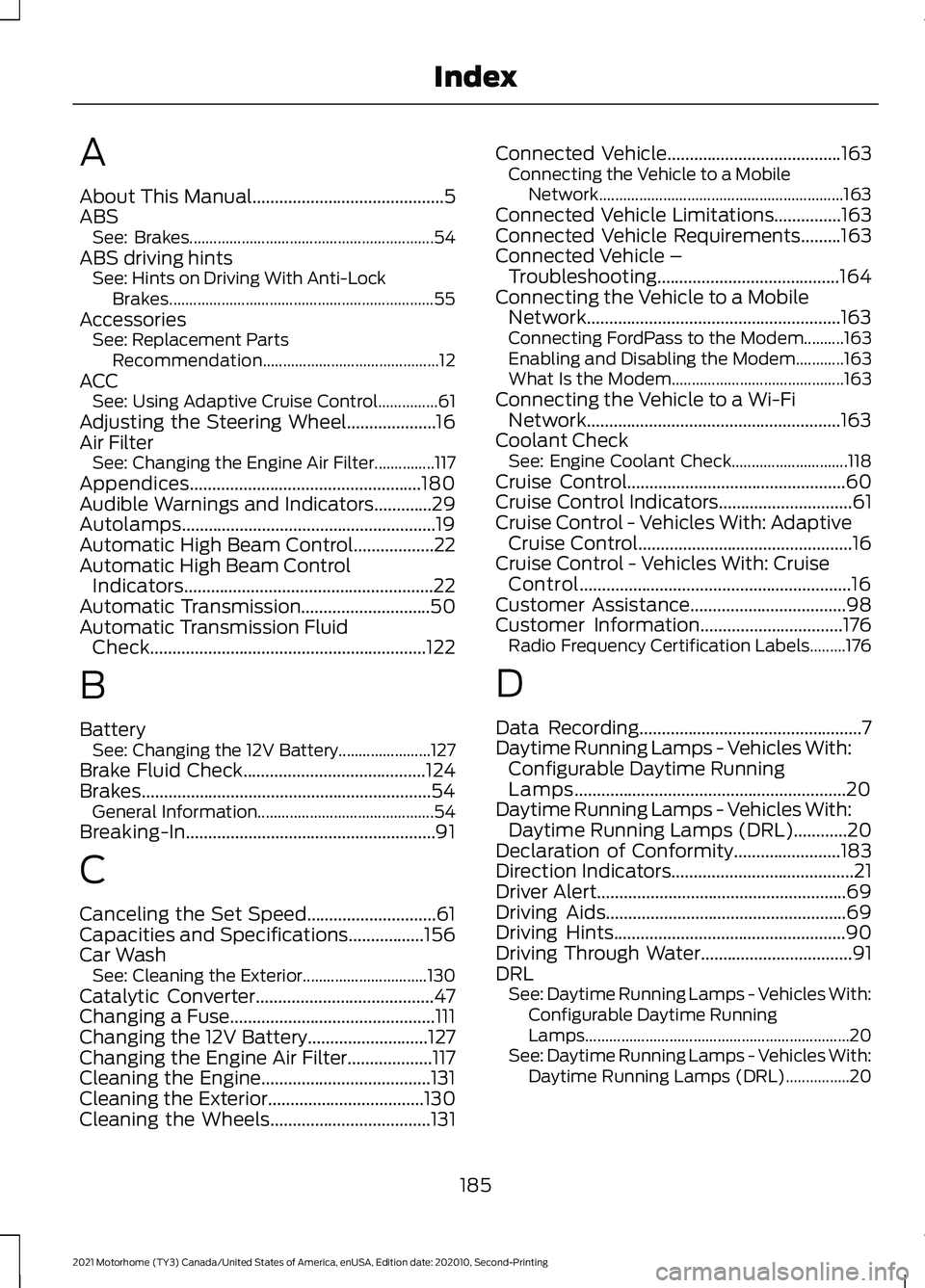
A
About This Manual...........................................5
ABS
See: Brakes............................................................. 54
ABS driving hints See: Hints on Driving With Anti-Lock
Brakes.................................................................. 55
Accessories See: Replacement Parts
Recommendation............................................ 12
ACC See: Using Adaptive Cruise Control...............61
Adjusting the Steering Wheel....................16
Air Filter See: Changing the Engine Air Filter...............117
Appendices....................................................180
Audible Warnings and Indicators.............29
Autolamps.........................................................19
Automatic High Beam Control..................22
Automatic High Beam Control Indicators........................................................22
Automatic Transmission.............................50
Automatic Transmission Fluid Check..............................................................122
B
Battery See: Changing the 12V Battery....................... 127
Brake Fluid Check.........................................124
Brakes.................................................................54 General Information............................................ 54
Breaking-In........................................................91
C
Canceling the Set Speed.............................61
Capacities and Specifications.................156
Car Wash See: Cleaning the Exterior............................... 130
Catalytic Converter........................................47
Changing a Fuse..............................................111
Changing the 12V Battery
...........................127
Changing the Engine Air Filter...................117
Cleaning the Engine......................................131
Cleaning the Exterior...................................130
Cleaning the Wheels
....................................131 Connected Vehicle
.......................................163
Connecting the Vehicle to a Mobile
Network............................................................. 163
Connected Vehicle Limitations
...............163
Connected Vehicle Requirements.........163
Connected Vehicle – Troubleshooting.........................................164
Connecting the Vehicle to a Mobile Network.........................................................163
Connecting FordPass to the Modem..........163
Enabling and Disabling the Modem............163
What Is the Modem........................................... 163
Connecting the Vehicle to a Wi-Fi Network.........................................................163
Coolant Check See: Engine Coolant Check............................. 118
Cruise Control.................................................60
Cruise Control Indicators..............................61
Cruise Control - Vehicles With: Adaptive Cruise Control................................................16
Cruise Control - Vehicles With: Cruise Control.............................................................16
Customer Assistance...................................98
Customer Information................................176 Radio Frequency Certification Labels.........176
D
Data Recording
..................................................7
Daytime Running Lamps - Vehicles With: Configurable Daytime Running
Lamps.............................................................20
Daytime Running Lamps - Vehicles With: Daytime Running Lamps (DRL)............20
Declaration of Conformity........................183
Direction Indicators
.........................................21
Driver Alert........................................................69
Driving Aids......................................................69
Driving Hints
....................................................90
Driving Through Water..................................91
DRL See: Daytime Running Lamps - Vehicles With:
Configurable Daytime Running
Lamps.................................................................. 20
See: Daytime Running Lamps - Vehicles With: Daytime Running Lamps (DRL)................20
185
2021 Motorhome (TY3) Canada/United States of America, enUSA, Edition date: 202010, Second-Printing Index
Page 190 of 191

P
Parking Brake...................................................55
Perchlorate.........................................................11
Power Steering Fluid Check......................126
Pre-Collision Assist........................................74
Protecting the Environment........................15
R
Radio Frequency Certification Labels.............................................................176
Cruise Control Module...................................... 176
Recommended Towing Weights..............84
Reduced Engine Performance..................90
Refueling...........................................................43
Replacement Parts Recommendation........................................12
Reporting Safety Defects (Canada Only)...............................................................103
Reporting Safety Defects (U.S. Only)...............................................................102
Resuming the Set Speed.............................61
Roadside Assistance....................................93
Roadside Emergencies
................................93
Running-In See: Breaking-In.................................................... 91
Running Out of Fuel......................................42
S
Safety Precautions
.........................................41
Scheduled Maintenance...........................168
Setting the Cruise Control Speed............60
Snow Chains See: Using Snow Chains.................................. 150
Special Notices................................................12
Special Operating Conditions Scheduled Maintenance................................................173
Speed Control See: Cruise Control............................................. 60
Stability Control.............................................58 Principle of Operation........................................ 58
Starter Switch See: Ignition Switch............................................. 37
Starting a Gasoline Engine..........................37
Starting and Stopping the Engine............37 General Information............................................ 37Steering..............................................................73
Steering Wheel
................................................16
Switching Automatic High Beam Control On and Off
.....................................................22
Switching Cruise Control On and Off....................................................................60
Symbols Glossary.............................................5
T
Technical Specifications See: Capacities and Specifications.............152
The Better Business Bureau (BBB) Auto Line Program (U.S. Only).......................100
Tire Care
...........................................................134
Tires See: Wheels and Tires...................................... 134
Towing a Trailer...............................................83
Towing the Vehicle on Four Wheels.......89
Towing................................................................83
Traction Control
..............................................57
Principle of Operation......................................... 57
Transmission Code Designation
.............155
Transmission...................................................50
Transporting the Vehicle.............................96
U
Under Hood Overview - Commercial Chassis............................................................114
Under Hood Overview - Motorhome Chassis............................................................115
Using Adaptive Cruise Control...................61
Using Snow Chains......................................150
Using Traction Control..................................57
V
Vehicle Care
....................................................130
General Information.......................................... 130
Vehicle Identification Number
.................154
Vehicle Storage..............................................132
VIN See: Vehicle Identification Number.............154
W
Warning Lamps and Indicators
.................27
187
2021 Motorhome (TY3) Canada/United States of America, enUSA, Edition date: 202010, Second-Printing Index